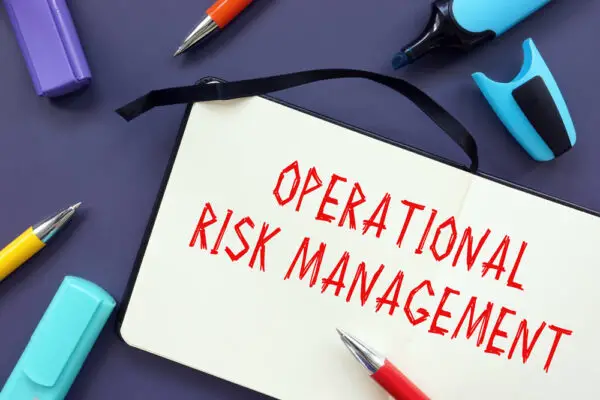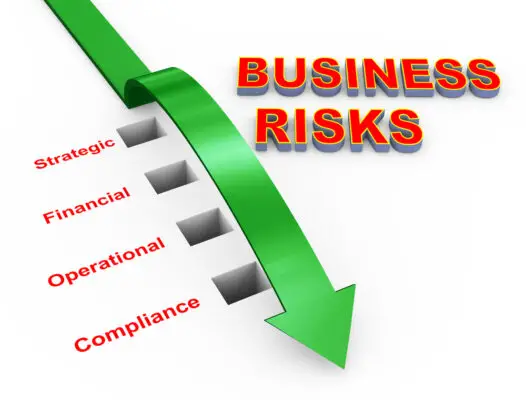Operational risk management is critical to any organization’s risk management strategy. It involves identifying, assessing, and mitigating risks arising from the business’s day-to-day operations.
This can include technological processes, human resources risks, and external factors such as regulatory changes or market conditions.
By proactively managing operational risks, organizations can reduce the likelihood and impact of potential incidents, protect their reputation, and enhance overall performance.
This requires a systematic approach, including risk identification, risk assessment, mitigation, and ongoing monitoring and review.
Effective communication and training are also essential to ensure all employees understand their roles and responsibilities in managing operational risks.
Understanding and effectively managing operational risk is vital to maintaining enterprise stability and continuity in an increasingly unpredictable business landscape.
Operational risk, which encompasses various internal and external threats, is integral to business functions and certainly poses significant disruption potential if not properly addressed.
This examination dives into the crucial components of managing these risks, from identifying factors to mitigating unforeseen challenges.
It further elaborates on various qualitative and quantitative risk identification methodologies and their pivotal role in an organization’s risk management strategy.
Moreover, it provides insights into critical aspects, such as risk assessment, modeling, tracking, and formulating proper response plans. Equally important is the role a company’s risk culture and digital resources play in operational risk management.
Understanding Operational Risk Management
Understanding Operational Risk Management
Operational Risk Management is a subset of risk management that focuses on the identification, assessment, and mitigation of risks associated with an organization’s daily operations.
This covers everything from its production processes and employee conduct to legal and technological risks. Operational Risk Management is crucial to an enterprise as it directly affects profitability and sustainability, often having short- and long-term repercussions.
In the simplest terms, operational risk refers to the risk of loss resulting from the inadequacy or failure of internal processes, people, systems, or external events.
This term includes tangible losses, such as financial and intangible losses, such as reputational damage.
Significance of Operational Risk Management to Enterprises
Proactive operational risk management enables an enterprise to anticipate potential pitfalls and effectively navigate them, ensuring business continuity and the preservation of profit margins.
It also supports the enterprise’s pursuit of its strategic goals, equipping decision-makers with a clear overview of potential operational hurdles.
Additionally, efficient operational risk management helps to improve productivity, builds trust with stakeholders, and can positively influence an organization’s reputation.
Within this context, operational risk management overlaps with various business functions, including human resources, information technology, legal, security, and finance.
Key Operational Risk Management Terms
Several key operational risk management terms are important for understanding the concept. These include:
- Risk: This represents an event or circumstance that could negatively affect a business.
- Hazard: This is a situation that poses a level of threat to life, health, property, environment, or reputation.
- Mitigation: This involves taking steps to reduce the severity and impact of the risk.
- Control: This refers to a measure that modifies risk.
- Risk Assessment: This involves identifying, analyzing, evaluating, and prioritizing the risks.
An Introduction to Operational Risks
Operational risks, typically divided into internal and external risks, can pose significant threats to the seamless operation of a business. These risks originate from different areas both in and out of an organization.
Internal risks typically stem from the business’s operational procedures or factors like employees, departments, or infrastructure. For instance, these risks could be due to insufficient staff training, outdated technology, or inadequate data security measures.
External risks, however, come from outside the business and are typically beyond the organization’s control. These could involve changes in compliance regulations, political instability, natural disasters, or swift shifts in market trends.
These internal and external risks can disrupt the organization’s operations, affecting the bottom line. Thus, an effective operational risk management system should take a comprehensive approach to minimize the impacts of both kinds of risks.

Identifying Operational Risks
Digging Deeper Into Operational Risks
Broadly, operational risks refer to potential setbacks arising from internal procedures, people, systems, or uncontrollable external factors that can hamper the normal functioning of a business.
These risks can manifest in various ways, from process errors, system failures, and misconduct, to severe business disruptions.
It’s significant to mention that operational risks aren’t limited to a particular section of an organization. Instead, they span throughout all departments and levels of an institution, from the top-management echelons right down to the frontline employees.
Identifying Operational Risks
The first step in managing operational risk is to identify possible threats.
Risk identification must be a continuous, proactive, and systematic process involving all key organisational stakeholders. There are various methods and strategies for identifying risks.
Qualitative Risk Identification Methods
Qualitative methods to evaluate risk typically involve systematically gathering expert opinions through brainstorming sessions or interviews to uncover potential risks.
These methods may also use risk checklists or previous risk audit reports. One commonly used qualitative tool is a SWOT analysis.
A SWOT analysis evaluates an organization’s strengths, weaknesses, opportunities, and threats and helps understand the potential risks and opportunities.
Quantitative Risk Identification Methods
Quantitative risk identification methods, on the other hand, rely on numerical measurements or statistical modeling to identify possible risk factors.
Examples include regression analysis, sensitivity analysis, or Monte Carlo simulations. These techniques might also employ statistical theories to predict operational risk.
Role of Audit Reports in Risk Identification
Audit reports also play a huge role in identifying operational risks. Through an analysis of financial and operational performance, internal audit teams can pinpoint areas of risk.
These audits might uncover evidence of system failures, employee misconduct, or regulatory non-compliance that could pose a risk to the organization.
The Importance of Continual Risk Identification
Risk identification is not a one-time activity. Risks evolve and change along with business requirements, technology, laws, and regulations.
Hence, the risk identification process has to be repeated consistently to identify new risks and re-evaluate existing ones.
Regular risk assessments can help the organization avoid potential threats and mitigate them before they escalate into major issues.
Organizational Roles in Identifying Risks
Everyone within an organization holds a critical role in identifying risks. The Board of Directors and high-level management are tasked with cultivating a culture that integrates risk awareness into every decision-making process.
Concurrently, employees should be encouraged to articulate any potential risks they may encounter in their everyday duties. This cooperative approach ensures that all possible operational risks are effectively identified and addressed.

Assessing and Measuring Operational Risks
Implementing Operational Risk Management
Operational risk management revolves around a comprehensive four-step strategy: identifying risks, conducting risk assessments, envisioning mitigation plans, and diligently monitoring these risks.
This systematic approach enables organizations to identify any potential threats to their operational effectiveness and preemptively develop strategies to offset those risks.
Identifying Operational Risks
The identification stage involves recognizing various risks that a business might encounter. These risks could revolve around internal factors like system failures, procedural shortcomings, or human errors.
External risks may include changes in market patterns, regulatory shifts, or technological advancements. Real-life examples of operational risk identification include a major bank revamping its cybersecurity measures after a data breach incident and a pharmaceutical company considering adverse legislative changes that could impact its operational structure.
Assessing Operational Risks
Once risks have been identified, they need to be assessed qualitatively or quantitatively. Qualitative measures are subjective and based on insights and experience.
For example, managers could use their knowledge and judgment to predict how alterations in production processes might influence the final output.
On the other hand, quantitative risk assessments use statistical data to predict potential loss. For instance, a transportation company could analyze historical accident rate data to anticipate the financial liability following a potential accident.
Risk Management Modeling
Risk modeling is an integral part of operational risk management. It’s a statistical process that uses data to anticipate possible outcomes.
A common example of risk modeling is a credit card company using credit scoring models to predict the likelihood of payment defaults. These models consider factors like income, credit history, and employment to forecast future risk.
Measuring Operational Risks
Risk measurement is the next step, which uses the assessments to quantify risks. It involves calculating a company’s potential losses if the risks materialize.
For example, a firm exposed to the risk of electricity cuts can quantify the costs of productivity loss, machinery damage, and employee overtime during such cuts.
Tracking Operational Risks
Finally, operational risk management involves regular tracking and reporting of risks. This process helps to monitor changes in risk profiles, achieve strategic objectives, and maintain a firm’s risk appetite.
It’s akin to a transportation company regularly reviewing accident rate data to measure financial liability and identify trends, enhance safety protocols, and ultimately avert accidents altogether.
In essence, operational risk management involves the critical assessment and measurement of potential risks, is a complex yet crucial process for businesses.
It requires the identification of these risks, their qualitative and quantitative evaluation, and the creation of risk models. Additionally, it also calls for risk quantification and consistent tracking over time.
Properly implementing a comprehensive operational risk management process can enable businesses to effectively manage unforeseeable situations, enhance judgment, increase productivity, and promote a risk-conscious culture.

Mitigating Operational Risks
Deep Dive into Operational Risk Management
Operational risk management signifies an ongoing procedure of pinpointing, assessing, and organizing risks that could potentially interfere with a business’s routine operations.
These can include risks associated with service disruption, reputational loss, legal liabilities, process or system failure, and financial harm.
Efficient management of operational risks enables organizations to decrease the potential negative impact on their reputation and financial performance.
Creating a Risk Response Plan
Creating a risk response plan begins with understanding the organization’s vulnerabilities and risks. This involves conducting a thorough risk assessment, typically carried out by risk management personnel, to understand the organization’s potential risks, their possible consequences, and the probability of their occurrences.
Once the risk assessment is complete, the organization can develop measures to address these risks. The response to each risk can vary, depending on its nature and severity. Responses can range from accepting the risk to mitigating, transferring, or avoiding it altogether.
Strategy Formulation and Establishing Risk Appetite
Formulating a risk management strategy includes establishing a clear risk appetite, which is the level of risk a company is willing to accept to achieve its objectives.
The board of directors commonly defines this risk appetite based on the organization’s strategic goals, culture, and the regulatory landscape.
The risk appetite sets the tone for risk management across the organization, guiding decision-making at every level. The risk appetite must be carefully calibrated; if it’s too aggressive, the organization might take on too much risk, but if it’s too conservative, opportunities for growth could be missed.
Role of Risk Policies and Compliance
Risk policies play a substantial role in mitigating operational risk. These policies outline how risks are identified, assessed, mitigated, and monitored within the organization.
They establish a framework for effectively managing risks aligned with the organization’s risk appetite. Likewise, compliance with internal and external regulations is crucial.
Companies must ensure that they comply with all relevant laws and regulations that pertain to their operations to mitigate legal and regulatory risks.
Preparation and Recovery from Operational Risk Events
Organizations should prepare for potential risk events as part of the operational risk management process. This could include developing business continuity, disaster recovery, or crisis management plans.
These plans should be tested and revised regularly to ensure they remain effective. After a risk event, organizations should conduct post-event assessments, determining what went wrong, how the response was handled, and what improvements can be made.
A significant part of recovery involves learning and adapting from these events to prevent similar issues in the future.
Operational risk management is a cyclic process rather than a one-off task. It entails continual monitoring and altering approaches based on emerging risks and the changing goals of an organization.
When properly addressed, it fortifies organizations against potential threats while ensuring valuable opportunities are not forsaken due to excessive risk evasion.

Risk Culture and Operational Risk Management
Decoding Risk Culture in the Context of Operational Risk Management
One aspect that significantly influences the management of operational risks is the risk culture inherent within an organization.
This concept of risk culture involves the perceived values, attitudes, and conduct towards risk within a company.
The way risk factors are woven into everyday activities—during decision-making procedures or communication channels—offers a potent reflection of the organization’s inherent risk culture.
The Role of Risk Culture in Operational Risk Management
A healthy risk culture empowers an organization to anticipate and handle risks effectively. It minimizes mistakes and encourages all members of an organization to take responsibility for risk management in their respective roles.
Employees in a company with a positive risk culture are likely to be more proactive in identifying potential hazards and more adept at taking necessary actions to mitigate these risks.
The Influence of Leadership on Risk Culture
Leadership plays a significant role in fostering a strong risk culture. Organizational heads demonstrate their commitment to risk management by prioritizing it, communicating its importance, and leading by example.
When leaders weave risk considerations into strategic planning and day-to-day operations, this can permeate the organization, prompting employees at all levels to adopt a risk-centric mentality.
Communication’s Contribution to Risk Culture
Transparent and regular communication also enriches an organization’s risk culture. Communication breaks down the silos in organizations, encouraging a more collaborative approach to risk management.
Clear communication of policies, procedures, and expectations improves the understanding and management of risk. It helps to build a culture where employees feel comfortable discussing and managing risks.
Training and Risk Culture Development
Last but not least, training plays a crucial role in developing a positive risk culture.
Regular training on risk management principles, processes, and tools equips employees with the knowledge and skills to identify and manage potential risks effectively.
It also signals the organization’s commitment to risk management, pushing employees to consider it an integral part of their roles.
A Closer Look at the Role of Risk Culture in Operational Risk Management
At the core of robust operational risk management is an effective risk culture. This involves cultivating a climate wherein the organization is well-equipped to predict, comprehend, and deftly handle risks.
Leadership, open dialogue, and continual training are key to creating and bolstering a resilient risk culture.
A vigilant orientation towards advancing a risk-conscious culture can prevent potential pitfalls and unveil new avenues for progress and advancement.

Operational Risk Management Technology
Understanding the Role of Technology in Operational Risk Management
Modern operational risk management strongly depends on the right technology. This includes leveraging digital platforms and data analysis to pinpoint, examine, and keep track of operational risk.
Such risks could result from inadequate or failed internal operations, people-related issues, system glitches, or unpredictable external events like fraud, accidents, etc.
Technology in operational risk management simplifies the process of early detection of such risks, thereby mitigating unwarranted risk exposures.
How Digital Tools and Analytics Support Risk Management
Technological innovations have transformed ORM, expanding its reach and effectiveness. For instance, Big Data and advanced analytics can analyze extensive amounts of data rapidly to identify potential patterns and risk indicators.
Supervisory control and data acquisition (SCADA) systems allow real-time operations tracking. These systems, combined with artificial intelligence (AI), can predict and track minute shifts, which could signal potential risks.
Risk management software supports thorough and efficient risk assessment procedures.
These applications enable organizations to identify and rank risks based on their likelihood and potential impact. They can flag up high-risk areas so that appropriate mitigation strategies can be implemented.
Cloud computing and mobile technology also play crucial roles. They ensure continuous monitoring and agility to respond to risks from anywhere, at any time.
For example, organizations can respond promptly if risks originate in a remote geographic location, thanks to mobile technology and cloud-based risk management systems.
Benefits of Technology in Operational Risk Management
Investing in risk management technology has several benefits. Accurate risk identification is one significant advantage; modern ORM technologies can identify risks more precisely than manual systems.
The result is less time spent rectifying mistakes and more time for strategic planning.
Risk management tools equipped with machine learning algorithms can predict potential risks based on past patterns and trends. In this way, businesses can stay one step ahead and mitigate risks promptly.
The use of technology also promotes uniformity. It establishes standardized risk assessment processes, leading to consistency throughout the organization.
It also mitigates the risk of human error, which can often be a weak link in risk management.
Challenges of Technology in Operational Risk Management
Despite its benefits, integrating advanced technology into risk management does present challenges. Initial financial outlay can be significant.
Data security is another issue; relying heavily on digital tools necessitates robust cybersecurity measures to protect sensitive business information.
There’s also the challenge of staying up-to-date with rapidly changing technology, which requires ongoing investment in updates and staff training.
Future Technological Trends in Operational Risk Management
Looking ahead, several technological trends could shape ORM. For instance, integrating AI and machine learning in risk prediction models can help take risk mitigation strategies to the next level.
Robotic Process Automation (RPA) could automate repetitive risk management tasks, reducing human error and freeing up time for strategic work.
Blockchain technology could also bring transformation, providing a secure and transparent way to track transactions and mitigate the risk of fraud.
And, with rising real-time threats like cyber attacks, businesses can anticipate an even greater reliance on technology in ORM.

Conclusion
As the extensive survey suggests, successful operational risk management leverages a mix of robust strategies, effective response plans, impactful roles at every organizational level, a strong risk culture, and advanced digital tools.
It is not just about identifying and measuring risks but also about devising effective mitigations and fostering a culture that understands and appreciates the importance of risk management.
In the face of an ever-evolving business environment, operational risk management is a dynamic and complex field, with new trends and technologies continually emerging.
Staying attuned to these changes and cultivating a proactive and insightful approach to risk management, organizations can thrive in the face of uncertainty, seizing opportunities while safeguarding their interests against potential disruptions.

Chris Ekai is a Risk Management expert with over 10 years of experience in the field. He has a Master’s(MSc) degree in Risk Management from University of Portsmouth and is a CPA and Finance professional. He currently works as a Content Manager at Risk Publishing, writing about Enterprise Risk Management, Business Continuity Management and Project Management.

